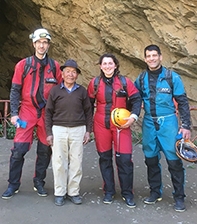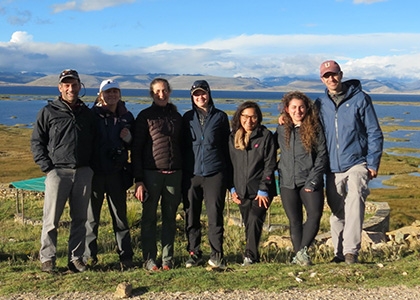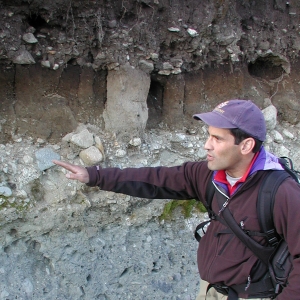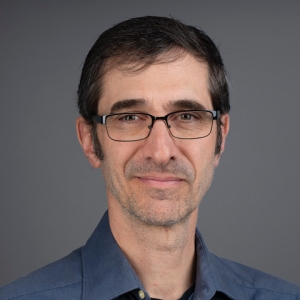Two Union College geology professors – Donald Rodbell and David Gillikin – are leading an international team of scientists in a project to develop the longest continuous paleoclimate record from the region known as the “heat engine” of Earth.
They are collecting lake sediments and cave deposits from the tropical Andes of Central Peru that hold important data about the Earth’s climate history and suggest what the future may hold.
Earlier research by the Union scientists and others has shown that climate stability is rare and that change –particularly at the regional level – can happen quickly, in a matter of decades, and that the globe is remarkably interconnected when it comes to natural climate variability.
The project, led by Union College, has received a $1.5 million award from the National Science Foundation. (Union’s share is $541,000). Other collaborating institutions are the University of Michigan, the University of Minnesota and the University of Pittsburgh. The grant will fund geochemical investigations of both a recently collected Lake Junín sediment core and nearby cave deposits in the eastern Peruvian Andes.
A 700,000-year-long sediment core was collected as part of the Lake Junín Drilling Project, a 2015 multimillion-dollar NSF-funded effort also led by Union College.
Climate patterns in the South American tropics – such as El Niño that warms water in the eastern Pacific – can have a profound global impact on water balance. “This project will help us understand the role of the tropics in global climate and will improve our ability to predict future droughts in a densely populated region of the world,” Rodbell said.
“The strength of this project is that we are combining two paleoclimate archives – lake sediments and cave stalagmites,” Gillikin said. “Each have strengths and weaknesses, but together they provide more information than either can independently."
Union College has strong ties to the Peruvian Andes, where Rodbell has spent about 35 years reading the paleoclimate records in lake sediments. Together, Rodbell and Gillikin bring expertise to merge lake records with cave records. Over the next three years, they will monitor the cave conditions to better understand how climate signals are recorded in the stalagmites. They will also collect more stalagmites for study.
The Union team got a jump start on reconstructing climate history in 2019, when the professors led eight students in a project to analyze the isotopes of oxygen and carbon in the stalagmites. Union is well positioned for this project with a stable isotope laboratory and the necessary equipment to sample stalagmites.
Rodbell and Gillikin are working with collaborators at the University of Michigan, the University of Minnesota, the University of Pittsburgh and several Peruvian institutions. Larry Edwards (University of Minnesota) has been dating the stalagmites using radiometric dating. Mark Abbott and Josef Werne (University of Pittsburgh) will explore leaf wax isotopes and organic molecules that reflect lake temperatures, and thus climate. Naomi Levin and Ben Passey (University of Michigan) will investigate clumped isotopes in both lake carbonates and the stalagmites.
An anonymous reviewer cited the potential of the project to “deliver high quality quantitative records of past temperature, precipitation, and evaporation for the region using a well-designed multi-proxy approach from the different archives (sediments and speleothems [cave deposits].”
The reviewer called the application “an exceptionally strong proposal with a high chance of success and with scientific outcomes that will be of use to the paleoclimate community.”
Read the NSF award announcement.



